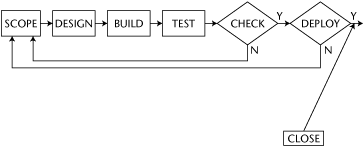The Closing Phase of the Extreme SDPM Strategy
Figure 36-1 illustrates the Closing Phase of the Extreme SDPM strategy.
Figure 36-1. The Closing Phase of the Extreme SDPM strategy

Note, first of all, that there is only one place where deployment of the solution can take place and that is after the final check. The final check results in either project completion or termination. Project completion occurs when the customer is satisfied that the project has converged on an acceptable solution and no further cycles will be launched. Solution and goal are now aligned and clearly defined. The final goal may be very different than the original goal. For example, the original goal might have been to cure cancer but the solution converged on a cure for colon cancer—still acceptable but not the initial vision. For another example, consider the case study.
Adaptive and Extreme SDPM strategies have very similar planning approaches. Both do planning just-in-time as a follow up to the cycle Closing Phases that lead to another cycle. In an Extreme SDPM strategy the deliverables for the next cycle are planned at the beginning of the cycle. In other words, it is just-in-time planning. In an Extreme SDPM strategy, you have to anticipate changes in direction for the project going forward. While this also happens in an Adaptive SDPM strategy the changes of direction are not as dramatic. The reason ...
Get Effective Software Project Management now with the O’Reilly learning platform.
O’Reilly members experience books, live events, courses curated by job role, and more from O’Reilly and nearly 200 top publishers.

